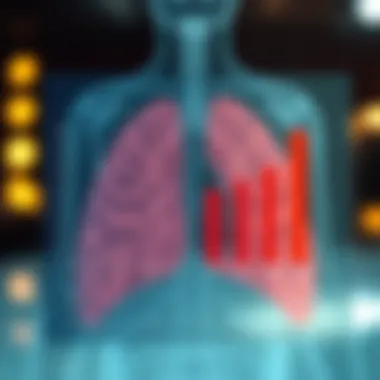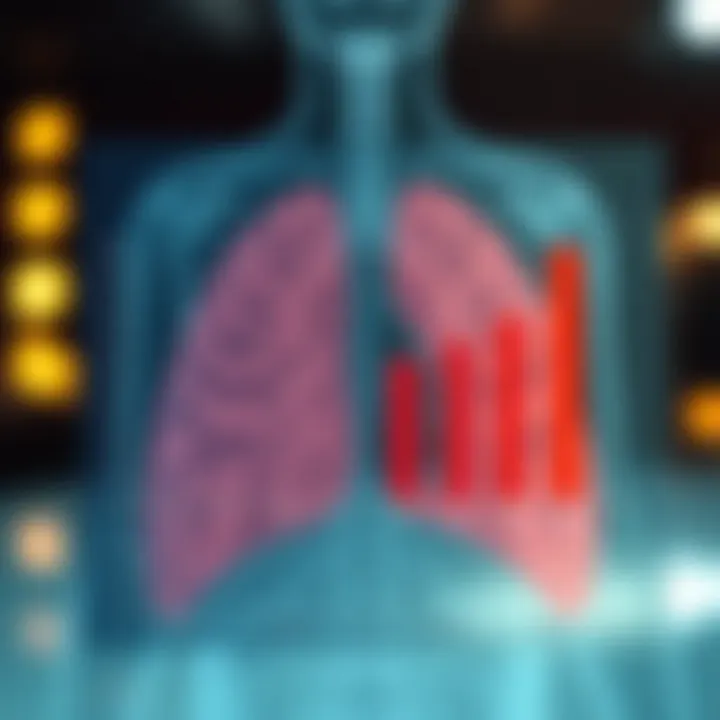Adenocarcinoma Lung Cancer: Life Expectancy Insights


Intro
Adenocarcinoma lung cancer is a prominent challenge in the field of oncology. Unlike other types of lung cancers that predominantly affect smokers, adenocarcinoma doesn’t discriminate; it can impact non-smokers just as severely. This particular form of lung cancer arises from glandular cells, typically found in the lungs, and accounts for a significant portion of lung cancer cases worldwide. Understanding the nuances of adenocarcinoma is not merely an academic exercise but a vital undertaking that resonates with patients, families, and healthcare providers alike.
The life expectancy for individuals diagnosed with adenocarcinoma can vary dramatically, influenced by a mosaic of factors including the stage at diagnosis, overall health, and advancements in treatment protocols. The complexities involved make it imperative to explore this subject comprehensively. This article aims to dissect the various components that contribute to life expectancy in patients with adenocarcinoma, examining biological underpinnings, treatment strategies, and relevant statistics.
Equipped with this information, students, researchers, educators, and healthcare professionals can make informed decisions, tailored to individual circumstances. Let’s delve deeply into the research highlights that illuminate the critical aspects surrounding this serious ailment.
Preamble to Adenocarcinoma Lung Cancer
Adenocarcinoma lung cancer presents a formidable challenge in the field of oncology, with its impacts cascading across various demographics. This particular form of lung cancer has garnered notable attention, particularly as it affects individuals regardless of their smoking history. Understanding the intricacies surrounding adenocarcinoma is quintessential for not just patients, but also for healthcare providers, educators, and family members who are engrossed in a journey that can be fraught with uncertainty.
Defining Adenocarcinoma
Adenocarcinoma refers to a type of cancer that originates in the glandular cells of the lungs. These cells are responsible for producing mucus and other substances that are crucial for normal lung function. Unlike other forms of lung cancer, adenocarcinoma typically arises in the peripheral regions of the lungs and is most commonly diagnosed in non-smokers. With its distinctive biological behaviors, understanding adenocarcinoma is essential. Knowledge of what adenocarcinoma entails helps patients better comprehend their diagnosis and the subsequent treatment paths.
Epidemiology of Lung Cancer
Lung cancer stands as one of the most prevalent cancers globally, and adenocarcinoma constitutes a significant portion of these cases. According to the American Cancer Society, approximately 234,000 new cases of lung cancer were estimated in 2021, with adenocarcinoma being the most common type. This statistic highlights a concerning trend as the incidence continues to rise, particularly among younger populations and women.
- Global Perspective: Countries with high smoking rates traditionally saw a higher prevalence of squamous cell carcinoma, but global shifts in smoking habits and environmental exposures have made adenocarcinoma increasingly common even among non-smokers.
- Trends and Observations: The rise in adenocarcinoma cases has been noted to correlate with increases in industrial pollution and second-hand smoke exposure, indicating that the environment plays a crucial role in lung cancer epidemiology.
Variability with Other Lung Cancer Types
Adenocarcinoma exhibits nuanced differences when compared to other lung cancer types like squamous cell carcinoma or large cell carcinoma.
- Histological Differences: The histology or tissue structure of adenocarcinoma can make it easier to identify under a microscope, often appearing gland-like in pattern. This differs significantly from squamous cell carcinoma, where the cancer arises from the flat cells lining the airways.
- Behavior and Growth: Adenocarcinomas tend to be slower-growing than small cell lung cancers, which are more aggressive. This slower growth can influence treatment decisions and ultimately impact patient life expectancy.
Understanding these distinctions can be vital for treatment planning and establishing realistic expectations for the patient's journey and outcomes.
Biological Characteristics of Adenocarcinoma
Understanding the biological characteristics of adenocarcinoma is pivotal in comprehending how this type of lung cancer functions, its progression, and its response to various treatment strategies. This section delves into the cellular structure and function of adenocarcinoma cells, as well as the genetic mutations and markers associated with them. Grasping these nuances helps elucidate not only diagnosis but also potential therapeutic avenues, thereby playing a crucial role in shaping treatment plans.
Cellular Structure and Function
Adenocarcinoma cells are distinguished by their glandular origin, often arising in the peripheral lung tissue. They deviate from the traditional squamous cell lineage prevalent in other forms of lung cancer. The cellular architecture is critical; adenocarcinoma cells form well-defined glandular structures, which can sometimes be mistaken for normal lung tissue during histopathological evaluation.
These cells primarily engage in the secretion of mucus and other substances, which complicates the pathology of lung cancer since increased secretion may lead to blockages and other respiratory challenges.
The microenvironment surrounding adenocarcinoma cells is also essential. These cells thrive in a unique ecosystem enriched by various growth factors and hormones that influence their behavior. When the balance within this microenvironment is disrupted, tumorigenesis can accelerate.
"The architecture of adenocarcinoma, with its distinct structural features, lays the groundwork for understanding how this cancer develops and spreads."
In addition, the interaction of adenocarcinoma cells with immune cells often illustrates how the tumor evades detection. This subversion of the immune response is a hallmark of cancer evolution. As such, insights into these cellular mechanisms can directly inform treatment approaches, emphasizing the necessity of targeted therapies.
Genetic Mutations and Markers
Genetic mutations play a pivotal role in the pathogenesis of adenocarcinoma, serving as both hallmarks and indicators of disease progression. The most common mutations include those in the EGFR, KRAS, and ALK genes. These mutations not only help in classifying the type of adenocarcinoma but also influence its aggressiveness and treatment response.
- EGFR Mutations: These mutations are particularly common in non-smokers and may predict sensitivity to certain targeted therapies, such as Tyrosine Kinase Inhibitors. This group of medications can substantially improve outcomes for patients with these mutations.
- KRAS Mutations: On the other hand, KRAS mutations are associated with a more aggressive disease and poorer prognosis. Unfortunately, treatments specifically targeting KRAS have historically been elusive, making it a critical area of ongoing research.
- ALK Rearrangements: Detection of ALK rearrangements can offer patients yet another avenue for targeted therapy, highlighting the necessity of genetic testing in adenocarcinoma.
Moreover, other markers, such as PD-L1 expression, are gaining traction in determining responses to immunotherapy, illustrating the complex genetic landscape of this cancer type. Deciphering these genetic blueprints not only aids in classification but also paves the way for personalized medicine strategies, that can yield better survival outcomes.
In summary, exploring the biological characteristics of adenocarcinoma, from cellular function to mutations, is integral to understanding this lung cancer's intricacies. These insights are vital for tailoring treatment approaches and consequently improving patient prognoses. For a deeper dive into lung cancer research and to stay updated, resources such as National Cancer Institute and American Cancer Society can provide valuable information.
Factors Affecting Life Expectancy
Understanding what influences life expectancy in individuals diagnosed with adenocarcinoma lung cancer is essential for patients, caregivers, and healthcare professionals. Several variables come into play, shaping the trajectory of the disease and the patient's overall survival. Identifying these factors enables informed decision-making regarding treatment and lifestyle choices, ultimately supporting better outcomes.
Cancer Stage at Diagnosis
The stage at which adenocarcinoma is diagnosed significantly impacts life expectancy. Doctors commonly use the TNM Staging System, which assesses the size of the tumor (T), lymph node involvement (N), and the presence of metastasis (M). A patient diagnosed with stage I cancer, when the tumor is localized and has not spread, generally has a more favorable prognosis compared to someone diagnosed at stage IV, where the cancer has metastasized to other organs. Hitting the nail on the head, detection at an earlier stage opens up a range of effective treatment options, enhancing survival probabilities and the overall quality of life.


Patient's Overall Health
Age
Age is more than just a number when it comes to cancer treatment and prognosis. Older patients often face a cocktail of health challenges, making treatment more complicated. As people age, their bodies undergo various changes that could impede their resilience against cancer. For instance, older individuals might also be dealing with chronic health issues that can further reduce treatment options. On the other hand, younger patients generally have better functional reserves and are more likely to withstand the rigors of aggressive treatments. Timely intervention, such as targeted therapies or surgery, can lead to more successful outcomes for younger patients.
Co-existing Conditions
The presence of co-existing conditions—such as diabetes, heart disease, or chronic respiratory issues—can play a heavy role in shaping a patient’s treatment trajectory and their life expectancy. These "comorbidities" can complicate the course of adenocarcinoma treatment by making the body less able to handle aggressive therapies. For example, patients with heart disease may be less tolerant of certain chemotherapy agents or surgical interventions. Recognizing these conditions early can help guide treatment decisions, focusing on balancing cancer therapy with the management of these concurrent health challenges.
Smoking History
Smoking history remains a cornerstone factor affecting life expectancy in lung cancer patients. Those with a history of smoking typically carry a heavier burden of disease, not only due to the direct effects of tobacco on lung health but also because of the increased likelihood of more aggressive cancer forms. The presence of smoking-induced damage can increase treatment risks and complicate recovery. Cessation programs or support systems can be crucial in assisting patients to quit, thereby improving their long-term outcomes post-diagnosis. Moreover, non-smokers usually enjoy a better outlook, as their bodies tend to respond more favorably to treatment options available, indicating the benefits of early intervention and lifestyle changes.
Biological Markers
Biological markers, including genetic mutations and other tumor characteristics, are increasingly recognized for their role in shaping life expectancy among adenocarcinoma patients. Knowing specific markers allows for more tailored treatment approaches.
Driver Mutations
Driver mutations are genetic alterations that play a key role in the development of cancer. In adenocarcinoma, common mutations include those in the EGFR and KRAS genes. Understanding these mutations provides insights into the most effective target therapies available. The presence of specific driver mutations can lead to distinct treatment paths. For instance, patients with an EGFR mutation might respond well to targeted therapies like Osimertinib. This targeted approach can lead to longer survival rates, demonstrating the importance of genetic profiling in shaping therapeutic options.
PD-L1 Expression
Programmed death-ligand 1 (PD-L1) expression is another critical biological marker related to lung cancer. Higher levels of PD-L1 in tumor cells can indicate that a patient might benefit from immunotherapy approaches. These therapies work by unmasking the cancer to the immune system, empowering the body to fight off the malignancy. However, not all patients with high PD-L1 expression respond uniformly, making it crucial for healthcare professionals to weigh the risks and benefits carefully during treatment planning.
Staging and Prognostic Indicators
Understanding the staging and prognostic indicators of adenocarcinoma lung cancer is paramount in determining not only the treatment options available but also in gauging the likely to be outcomes for patients. Staging provides a framework for categorizing the extent of the disease; this categorization is pivotal in guiding clinical decisions. Having clear insight into the staging allows healthcare providers to tailor treatment plans specific to the patient’s condition, thereby enhancing the efficacy of interventions.
Prognostic indicators, which consider various factors affecting survival rates, further refine this picture. They provide deeper insights into how the individual will respond to treatments and the eventual trajectory of the disease. Thus, both staging and prognostic evaluations are crucial for strategic planning in the management of adenocarcinoma lung cancer.
The TNM Staging System
The TNM staging system stands for Tumor, Nodes, Metastasis. This classification is universally accepted and serves as a cornerstone for understanding cancer progression, particularly in lung cancers.
- Tumor (T) denotes the size and extent of the primary tumor. The classification ranges from T1 to T4, indicating growth from a small tumor to large tumors that may involve nearby organs.
- Nodes (N) refer to whether the cancer has spread to nearby lymph nodes. The presence and number of affected nodes significantly influence prognosis.
- Metastasis (M) indicates whether cancer has spread to distant organs. Any metastases (M1) generally suggest a poorer prognosis compared to localized diseases (M0).
The specific combinations of these categories yield a detailed picture of cancer stage, which is crucial for determining treatment strategies.
Prognostic Scores
Prognostic scores help quantify the risk of cancer progression and the patient’s overall prognosis. Two critical elements to consider in this context are performance status and comorbidities.
Performance Status
Performance status is a measure of a patient’s general health and ability to carry out daily activities. The most commonly used scores are the Eastern Cooperative Oncology Group (ECOG) performance status and the Karnofsky performance scale. An individual’s performance status can range from fully active to completely disabled.
The key characteristic of performance status is its role in guiding treatment decisions. It helps clinicians predict how well a patient might tolerate various therapies. A patient with a high performance status, for example, is more likely to endure aggressive treatment options, which may lead to improved outcomes.
One unique feature of performance status is its ability to incorporate subjective and objective measures. This duality can present advantages, yet it also might introduce variability based on personal perceptions of well-being, ultimately affecting treatment considerations.
Comorbidities
Comorbidities encompass other health conditions a patient may have concurrent to lung cancer. These could range from diabetes, heart disease, to chronic obstructive pulmonary disease (COPD). The presence of comorbidities is crucial as they can significantly impact treatment outcomes and overall life expectancy.
The salient aspect of comorbidities is their predictive value. They often correlate with increased complications during treatment, making careful management essential.
What sets comorbidities apart is their variability across individuals. Thus, while they pose challenges, understanding and managing these comorbid conditions can lead to tailored treatment approaches, improving overall patient outcomes.
An important takeaway is that the interplay between performance status and comorbidities offers a comprehensive view of a patient’s health—guiding not only treatment strategies but also realistic expectations regarding patient prognosis.
"A comprehensive assessment of staging, performance status, and comorbidities fosters informed treatment decisions, enhancing patient care and quality of life."


For further reading and additional resources, consider visiting the National Cancer Institute here or the American Cancer Society here.
Treatment Modalities and Their Impact
The treatment of adenocarcinoma lung cancer is a pivotal element that informs patient outcomes and life expectancy. It encompasses a spectrum of approaches tailored to combat the complexities of the disease. Each treatment method holds its own weight in determining the course of the illness, affecting survival rates and quality of life. Minimally invasive surgical procedures, potent chemotherapies, and innovative targeted therapies work in tandem to form a comprehensive strategy against this aggressively advancing malignancy. Understanding these modalities provides a foundational insight into how they can alter the trajectory of a diagnosis, making informed choices all the more critical for patients and their families.
Surgical Interventions
Surgery often serves as a frontline approach in addressing localised adenocarcinoma lung cancer. When applicable, surgical intervention can potentially lead to cure, especially if the cancer is detected at an early stage. Lobectomy, where an entire lobe of the lung is removed, is a common surgical method employed. This can reduce the tumor burden significantly. However, such procedures demand a careful risk assessment, considering the patient's overall health and lung function. Post-surgical recovery is a major concern, as patients may experience diminished respiratory capacity or complications that require ongoing management.
Chemotherapy Options
Chemotherapy remains a cornerstone treatment modality for adenocarcinoma lung cancer, particularly in advanced stages. This approach uses powerful drugs to target cancer cells, often with the intent to shrink tumors or control their spread. Agents like carboplatin and paclitaxel are frequently used, either in combination or sequentially. While chemotherapy can be effective, the side effects, such as fatigue, nausea, and hair loss, can significantly impact a patient’s quality of life. It is essential for patients to understand these potential ramifications when weighing the benefits versus the discomforts of treatment.
Targeted Therapies
Targeted therapies have revolutionized the oncology landscape, particularly for adenocarcinoma lung cancer. These treatments function by specifically addressing genetic mutations or alterations found in cancer cells.
EGFR Inhibitors
EGFR inhibitors, such as erlotinib and gefitinib, are designed to inhibit the epidermal growth factor receptor, which is overactive in a substantial subset of lung adenocarcinomas. Their specificity denotes a significant advantage, as they often yield better responses with lower toxicity compared to traditional chemotherapy. Notably, these inhibitors can lead to impressive progress in survival rates for patients harboring EGFR mutations. However, resistance can develop over time, leading oncologists to continuously tailor treatment plans to the changing landscape of the disease.
ALK Inhibitors
ALK inhibitors, including crizotinib and enantinib, target abnormalities associated with the anaplastic lymphoma kinase gene. These targeted therapies represent a strong option particularly for younger patients, often resulting in substantial tumor shrinkage. Their prompt action can delay progression and enhance the quality of life. Yet, much like EGFR inhibitors, challenges arise as tumors can adapt, necessitating ongoing research and new strategies to combat resistance.
ROS1 Inhibitors
For patients with ROS1 gene rearrangements, the use of ROS1 inhibitors like crizotinib plays a critical role. These treatments inhibit signals that prompt cancer cell growth. What's compelling is how effective they have proven in terms of response rates, and they can bring forth significant improvement in progression-free survival. However, they are not without their drawbacks, as potential side effects may still influence treatment adherence.
Immunotherapy Approaches
Immunotherapy represents a burgeoning frontier within adenocarcinoma treatment. By training the immune system to recognize and combat tumor cells, this strategy offers hope for patients who might not respond to other treatments. Agents like nivolumab and pembrolizumab have shown promising results, promoting an invigorating discussion among healthcare practitioners regarding their indication and application in managing adenocarcinoma. Nevertheless, understanding patient eligibility based on genetic and biological markers is crucial to enhancing potential benefits from immunotherapy.
In summary, the landscape of treatments for adenocarcinoma lung cancer is both intricate and evolving. Patients need to be informed of their options, including the impact of each modality on their health, longevity, and overall well-being. The collaboration between medical professionals and patients is key in ensuring that each individual receives the most appropriate and effective treatment based on their specific circumstances.
Survival Statistics and Research Findings
Survival statistics serve as an invaluable resource in understanding the prognosis for individuals diagnosed with adenocarcinoma lung cancer. These figures not only help in comprehending overall trends in survival but also assist healthcare providers and patients in making informed decisions about treatment options and expectations. The core of these statistics lies in their reflection of broader patterns related to cancer management and outcomes, which can vary significantly based on multiple factors like stage at diagnosis, individual health, and treatment choices.
Understanding survival rates can provide insight into the effectiveness of treatments and the natural progression of the disease. As we delve into adenocarcinoma lung cancer, it’s critical to recognize that these statistics are not just numbers; they embody the experiences of countless individuals and families facing similar challenges.
Five-Year Survival Rates by Stage
Five-year survival rates are often used as a standard metric in oncology to assess the prognosis of cancer patients. For adenocarcinoma, these rates can vary quite dramatically depending on the stage at which the cancer is diagnosed.
Here’s a breakdown of five-year survival rates according to the stage of adenocarcinoma lung cancer:
- Stage I: At this nascent stage, when the cancer is localized primarily in the lungs, the five-year survival rate can exceed 70%. Early detection often allows for more effective treatments, significantly improving quality of life.
- Stage II: As the cancer begins to spread to nearby lymph nodes, the survival rate generally drops to approximately 50%-60%. This stage still allows for treatment options, but the disease's progression necessitates a more aggressive approach.
- Stage III: This stage indicates more extensive spread of the cancer. Here, the five-year survival rate can hover around 30%-40%. Patients may undergo sophisticated treatment plans, including a combination of chemotherapy, radiation, or surgery.
- Stage IV: At this advanced stage, survival rates plummet to around 5%-10%, as the cancer has metastasized to other organs like the liver, bones, or brain. While treatment becomes more about managing symptoms and enhancing life quality, there are still options like targeted therapies.
"Understanding the stage at which adenocarcinoma is diagnosed can profoundly impact survival outcomes and treatment decisions."
Trends in Survival Over Time
The landscape of cancer treatment is constantly evolving. Over the years, the trends in survival rates for adenocarcinoma lung cancer have shown gradual improvement, reflecting advancements in medical research and treatment modalities.
Recent data suggests an upward trend, particularly thanks to innovations in targeted therapies and immunotherapy. Here’s a closer look at these trends:
- Improved Treatments: The introduction of breakthrough medications targeting specific genetic mutations has revolutionized treatment, especially in non-smokers and those with specific driver mutations like EGFR and ALK.
- Increasing Awareness: More public awareness regarding lung cancer symptoms and risk factors has facilitated earlier diagnoses, contributing positively to survival statistics.
- Research and Development: Ongoing clinical trials have been pivotal in providing new therapeutic options, leading to better patient outcomes. For example, newer drugs are showing promise, with ongoing research finding ways to extend the efficacy of existing treatments.
- Access to Care: Enhanced access to oncological care and integrated treatment approaches have been shown to improve outcomes. Patients receiving multidisciplinary care often report higher survival rates compared to those who do not.
End
In summary, survival statistics and research findings provide a crucial lens through which we can view adenocarcinoma lung cancer. They not only inform prognoses but also drive research and treatment innovations. As we continue to grapple with this challenging disease, understanding these findings can help individuals and their families make sense of the journey ahead, from diagnosis to treatment planning.


For more detailed insights into cancer survival rates and ongoing studies, resources such as the National Cancer Institute (nci.nih.gov) and peer-reviewed journals are worth exploring.
Quality of Life Considerations
When discussing adenocarcinoma lung cancer, the notion of quality of life often emerges as one of the most pivotal themes. Quality of life does not just refer to the absence of cancer but encapsulates the overall well-being of a patient, including physical, emotional, and social aspects. Various factors can heavily influence quality of life, from the treatment options available to the psychological burden that often accompanies a cancer diagnosis. Given that adenocarcinoma lung cancer can present significant challenges to patients and their families, examining these considerations becomes ever-so-important.
Physical Health Impacts
The physical health impacts related to adenocarcinoma can vary widely among patients. Some might experience debilitating symptoms, while others may navigate their treatment with moderate discomfort. Common physical implications include:
- Breathlessness: This symptom is prevalent due to tumor progression or side effects of treatment like chemotherapy or radiation.
- Fatigue: A common yet challenging issue, fatigue is not simply tiredness; it can significantly hinder daily activities and reduce overall enjoyment of life.
- Pain: Depending on the tumor’s location, patients may encounter localized pain. Managing this can be crucial for maintaining quality of life.
- Nutritional Concerns: Many patients struggle with appetite loss or changes in taste, complicating their nutritional intake and affecting general health.
Consider seeking support from nutritionists or physical therapists to mitigate some of these health challenges. It’s important for patients and their families to remain proactive about monitoring these impacts.
"In the face of uncertainty, managing physical health becomes paramount for maintaining quality of life."
Psychological Aspects
The mental toll of adenocarcinoma lung cancer cannot be overstated. When facing a cancer diagnosis, psychological well-being often takes a hit. Patients might wrestle with:
- Anxiety: Concerns about one’s health, treatment outcomes, and the future can lead to overwhelming anxiety.
- Depression: Feelings of sadness, isolation, and despair can be pronounced, often necessitating intervention.
- Fear of Recurrence: Even after treatment, the fear of cancer returning holds significant emotional sway over many patients, influencing their interactions and overall outlook on life.
One potential avenue for addressing these challenges involves engaging with mental health professionals. Therapy, support groups, and counseling may provide invaluable coping strategies. Open and honest communication about feelings with loved ones can also greatly alleviate psychological stress.
In summary, recognizing and understanding the quality of life considerations when dealing with adenocarcinoma lung cancer is essential. Both physical and psychological impacts come into play as patients navigate their journey. As advancements in treatment persist, the hope remains that supportive care will evolve in tandem, ensuring that patients not only survive but thrive in the face of cancer.
Future Directions in Research
The landscape of adenocarcinoma lung cancer is constantly evolving as researchers and clinicians strive to enhance patient outcomes. Understanding future directions in research is vital for predicting better therapeutic strategies and ultimately improving life expectancy. This area is essential not just for academics but for healthcare providers and patients alike, as the implications of their findings could redefine existing treatment protocols and introduce novel approaches.
Novel Therapeutic Approaches
The emergence of innovative treatment methods marks a pivotal turning point in the handling of adenocarcinoma. Clinical trials are increasingly exploring therapies that merge advanced technology with traditional treatment modalities. For instance, researchers are looking into the use of nano-medicine, which involves creating nanoparticles that can target cancer cells with pin-point precision, minimizing damage to surrounding healthy tissue.
A few of the promising avenues include:
- Adoptive Cell Transfer: This technique involves engineering a patient's own immune cells to recognize and combat cancer more effectively.
- Oncolytic Virus Therapy: Utilizing genetically modified viruses that selectively infect and destroy cancer cells while sparing normal cells is being considered as an exciting frontier.
- CAR-T Cell Therapy: This approach modifies T cells to better detect and eliminate cancer cells. Its potential application in lung cancer is under exploration.
The pursuit of these therapies is not merely academic; they're aimed at enhancing patient quality of life and extending survival rates. What makes these advancements even more significant is their potential to open doors to personalized medicine, where treatment is tailored to the individual characteristics of each patient’s cancer.
Genomic Research Implications
Delving into the genetic make-up of adenocarcinoma lung cancer is another area gaining traction among researchers. Understanding the genomic landscape can provide crucial insights into why certain therapies succeed or fail. The identification of specific mutations, for instance, allows for the development of targeted therapies that can significantly improve the effectiveness of treatment.
The implications of genomic research in adenocarcinoma are multi-fold:
- Biomarker Development: Novel techniques are steering towards identifying biomarkers that could predict treatment response, substantially aiding clinical decision-making.
- Understanding Resistance Mechanisms: Genomic studies shed light on why some patients develop resistance to standard treatments, thus guiding the development of next-generation therapeutic approaches to overcome such challenges.
- Collaborative Databases: Initiatives like The Cancer Genome Atlas (TCGA) are expanding repositories of genetic information. Such collective databases empower researchers globally, allowing for accelerated discovery processes and the analysis of vast swathes of genetic data across diverse populations.
In summation, the future of adenocarcinoma lung cancer research looks promising. With advancements in therapeutic methods and a deeper understanding of the disease at a molecular level, the potential to extend life expectancy and improve patient quality of life is on the horizon. These realms of research signify hope and excitement, underscoring the need for continued investment and support in oncology research initiatives.
"Research is creating new knowledge." — Neil Gaiman
For further information on lung cancer research and resources, you can visit Cancer.gov or Lung.org.
The End
In summary, understanding the intricacies of adenocarcinoma lung cancer is vital for patients and their families, as well as for health professionals involved in treatment and support. Life expectancy for those diagnosed with this particular type of lung cancer is influenced by a plethora of factors, all of which merit careful consideration. It’s not just about the cancer stage at diagnosis, but how individual health circumstances play a role in outcomes. Notably, patients’ age, comorbidities, and lifestyle factors such as smoking history can significantly sway the prognosis.
Synthesizing Key Insights
Synthesizing the key insights surrounding adenocarcinoma lung cancer reveals a landscape steeped in complexity. Five-year survival rates vary dramatically based on early detection and personalized treatment approaches. Moreover, as research strides ahead, it's crucial to remain updated on advancements in therapies, which include targeted options and immunotherapies. These developments hold promise in enhancing not only life expectancy but also quality of life for patients.
- Early intervention is critical: Catching the disease in its initial stages can dramatically improve survival prospects.
- Personalized medicine: Tailoring treatments to individual genetic markers can lead to better outcomes than one-size-fits-all approaches.
- Holistic health: Addressing patients' overall health, including psychological support, is as important as the physical treatment.
Ongoing Need for Research and Support
The pressing need for ongoing research and support cannot be overstated. As new findings emerge, continuous inquiry into the genetic and environmental factors influencing adenocarcinoma will enhance understanding and, ultimately, treatment efficacy. Toward this end, public and private funding play pivotal roles; both are essential in advancing studies aimed at uncovering novel therapeutic targets and refining existing protocols in care. Patient advocacy and community support networks must also be cultivated to assist those navigating through diagnosis and treatment hurdles.
The synergistic effort of researchers, healthcare providers, and families can make a marked difference in outcomes for future patients.
As we grasp the significance of collaborative support and innovative research, the hope is that we can rewrite the narrative for those affected by adenocarcinoma lung cancer. The journey is undoubtedly challenging, but every step toward understanding is one step closer to a world where life expectancy can improve significantly.



